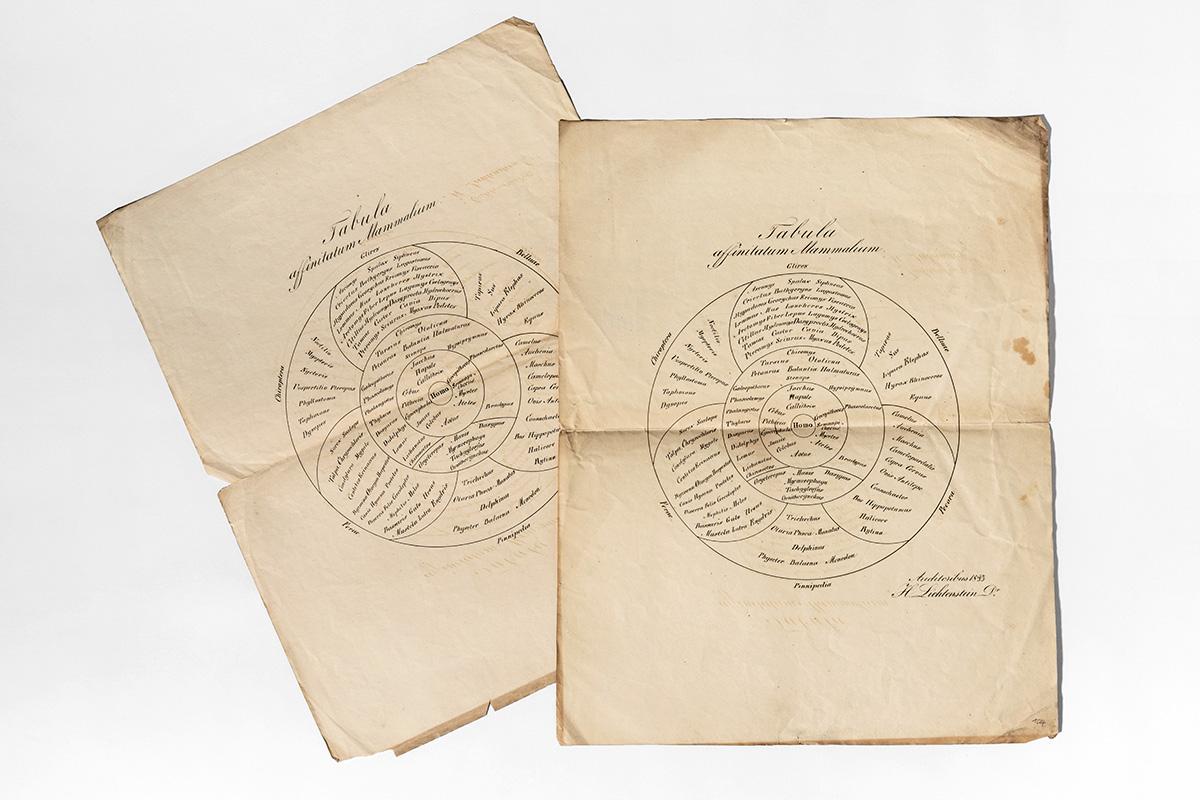Anne MacKinney
Humankind, Homo, stands at the centre. It forms the anchor point of the Tabula affinitatum Mammalium, a circular chart of mammals designed by zoology professor Martin Hinrich Lichtenstein (1780–1857) for his lecture at the Berlin University in the winter semester of 1834. Encircling the humans at the heart of the concentric rings are various primates. The primates, in turn, are surrounded by marsupials, who themselves are joined by aardvarks and armadillos. Rodents, hooved creatures, aquatic mammals, carnivorans and bats gather along the outer orbit of chart. Gracefully curved arcs flow between the different mammals, creating borders, but also bridges: the flying squirrels and gliders, for instance, hover close to the flying foxes, while the nocturnal dormice doze alongside the nocturnal aye-ayes. Shared characteristics and not just taxonomic affiliation determine the arrangement of genera across the diagram.
The printed image described here is located amidst the administrative papers of Lichtenstein, who was not only one of the first professors at the Berlin University, established in 1810[AM1] , but also an early director of the Zoological Museum. Two versions of this print are now preserved in the Historical Division of the Berlin Museum für Naturkunde. In an archival folder otherwise filled with invoices, receipts, reports, instructions, and inventory lists, the pages stand out as the only images and as rare evidence of Lichtenstein's teaching activities.
The chart is at once an expression of utter bewilderment towards nature’s overwhelming diversity and an optimistic attempt to establish its clear order. Already since the middle of the eighteenth century, the traditional image of nature as a linear chain – the scala naturae – was breaking apart. Nature had become too multifaceted: Around 1740, the taxonomist Carl von Linné (1741–1783) had already counted around 600 animal species; a hundred years later, naturalists estimated that mammal species alone numbered in the 2,000s and that insects comprised as many as 44,000 species. To capture the complex connections between the growing number of animal groups, eighteenth-century researchers increasingly turned to images of webs and nets. Yet these visualisation efforts often resulted in an unmanageable, barely legible tangle of knotted threads.
As director of a rapidly expanding zoological museum, Lichtenstein, too, felt the pressure of a scarcely controllable, 'chaotic' nature. With his elegant, nearly symmetrical circle, which seemingly rendered unto humans the power to organize the world around them, Lichtenstein tried to tame nature’s bounty. He only briefly succeeded. A few years after creating this image – animal names and specimens had only continued to increase in the meantime – Lichtenstein wrote defeated: "[...] the new age is becoming too much to handle [...] such that one feels that one can no longer get ahead and is too stupid and ignorant for the new drivelling systematics and nomenclature – at least too weak to swim against the current."
Object Profile
- Title: print Tabula affinitatum Mammalium
- Signature: ZM S I Lichtenstein II Bl. 104
- Provenance: Royal Zoological Museum of the Friedrich-Wilhelms-Universität zu Berlin
- Materials: paper, ink, print
- Author: draft by Prof Dr Martin Hinrich Lichtenstein (1780–1857), print by anonymous,
- Date of production: around 1834
- Place of production: Berlin, Kingdom of Prussia
- Keywords: scala naturae, net, natural affinities, taxonomy, classification, zoology, mammals
Sources
- Karl Ernst von Baer: "Blicke auf die Entwickelung der Wissenschaft. Vortrag in der öffentlichen Sitzung der Akademie der Wissenschaften zu St. Petersburg am 29. Dec. 1835", in: Reden gehalten in wissenschaftlichen Versammlungen und kleinere Aufsätze vermischten Inhalts. Erster Theil: Reden, St. Petersburg 1864, pp. 76–160, digital copy in the Bayerische Staatsbibliothek digital (last accessed: 19.10.2020).
- A[ugust] J[ohann] G[eorg] C[arl] Batsch: Tabula affinitatum regni vegetabilis, quam delineavit, et nunc ulterius adumbratum, Vinaria [Weimar] 1802, DOI 10.5962/bhl.title.7569 (last accessed: 19.10.2020).
- Johann Herrmann: Affinitatum animalium tabulam brevi commentario illustratam praeside Johanne Herrmanno &c in alma Argentoratensium Universitate Academicis exercitationibus ventilandam &c proponit Georg, Argentoratum [Strasbourg] 1777, digital copy in the catalog of the Wellcome Collection (last accessed: 19.10.2020).
- Johann Herrmann: Tabula affinitatum animalium olim academico specimine edita: nunc uberiore commentario illustrate cum annotationibus ad historiam naturalem animalium augendam facientibus, Argentoratum [Strasbourg] 1783, DOI 10.5962/bhl.title.58872 (last accessed: 19.10.2020).
Image Credits
- Tabula affinitatum mammalium, print, draft by Martin Hinrich Lichtenstein, print by anonymous, around 1834, 42 x 33 cm, HBSB, Zool. Mus., S I Lichtenstein II, folio 104, © Carola Radke, MfN.
